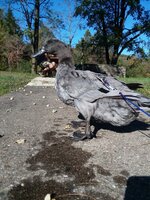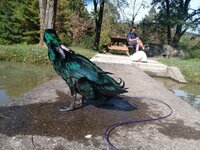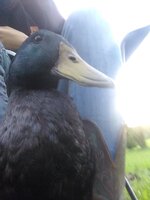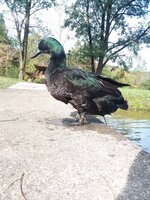I have a Cayuga mix (though she looks exactly like a Cayuga--and she even breeds true) who's been getting a little whiter after each mating season (that's when the white feathers start coming in). Last year, I had a crazy Pekin drake that would harass her constantly. He refused to mate with any of the other hens, he'd only mate with her. He was NOT gentle, he ended up ripping all of the feathers out of the back of her head, but then he died due to a bubblefoot complication just before the fall. Most of them grew back in white, so she has this ugly speckled oblong stripe down the back of her neck now. I'm waiting for her to go white, but she's only two. She's such a sweetie, though! Broody, too.
Her father had a full-bodied purple sheen, but she has green, and blue on her wings. I'm trying to breed the sheen out and get some matte black ducks, like the original Cayugas, but I've had little luck so far. I'm think of even breeding some American Black Duck back into the mix to keep them as close to the originals as possible. Her dam was a Blue Swedish, which is why the black transferred so well.



 This second duck is her daughter, the sire is the Pekin that I mentioned earlier. I'm liking how the sheen is diluted on her, but she has white leakage under her beak, and brown barring under her wings. It's not really a serious breeding project, just a little fun with what I have on hand, so I'm not too concerned. At this point, I'm just excited to see all of the colors that my F2 hybrids hatch out as!
This second duck is her daughter, the sire is the Pekin that I mentioned earlier. I'm liking how the sheen is diluted on her, but she has white leakage under her beak, and brown barring under her wings. It's not really a serious breeding project, just a little fun with what I have on hand, so I'm not too concerned. At this point, I'm just excited to see all of the colors that my F2 hybrids hatch out as!
I'm considering building a second enclosure (though it may have to wait a while, I don't have much space left unless I clear out some forest) to breed a legitimate flock of show Cayugas, and experiment with some American Black Ducks to get rid of the sheen then.
Her father had a full-bodied purple sheen, but she has green, and blue on her wings. I'm trying to breed the sheen out and get some matte black ducks, like the original Cayugas, but I've had little luck so far. I'm think of even breeding some American Black Duck back into the mix to keep them as close to the originals as possible. Her dam was a Blue Swedish, which is why the black transferred so well.
I'm considering building a second enclosure (though it may have to wait a while, I don't have much space left unless I clear out some forest) to breed a legitimate flock of show Cayugas, and experiment with some American Black Ducks to get rid of the sheen then.








